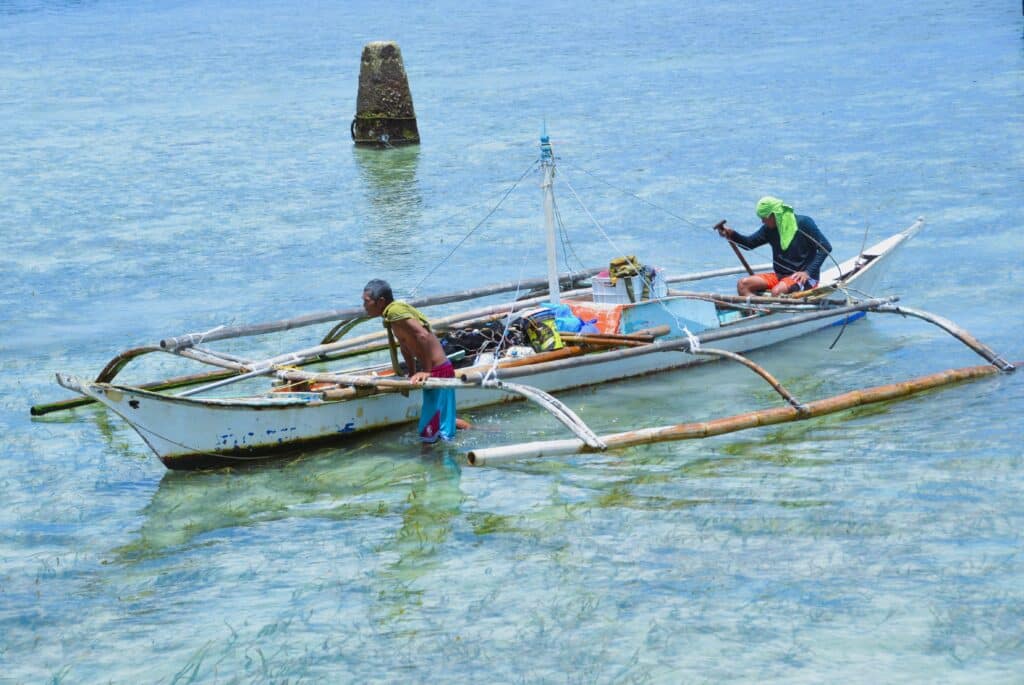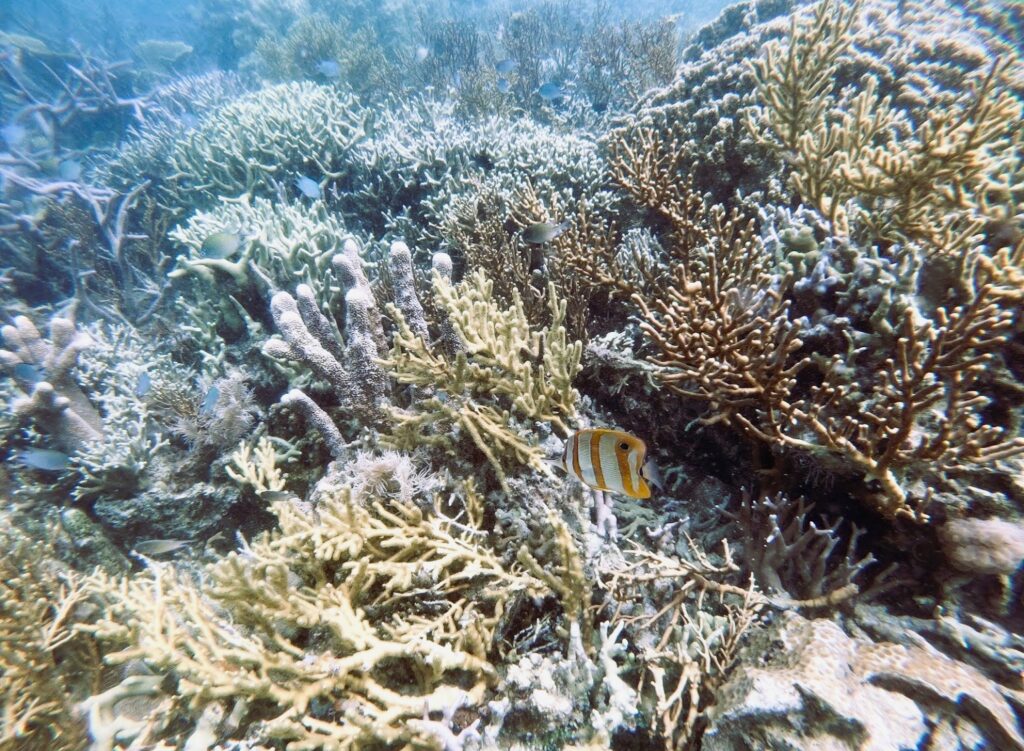Text by Henrylito D. Tacio
Photos by Gregory C. Ira
You wouldn’t usually associate fish with coral reefs but an estimated 10% to 15% of the total fisheries in the Philippines come from coral reefs. About 80% to 90% of the income of small island communities come from fisheries.
As Dr. Angel C. Alcala, a marine scientist and former secretary of the Department of Environment and Natural Resources (DENR), said when he was still alive: “Coral reef fish yields range from 20 to 25 metric tons per square kilometer per year for healthy reefs.”
Come June 1, environmentalists, social activists, journalists, and politicians, among others, from around the globe will celebrate World Reef Awareness Day “to create awareness among various business communities and the general public about the fragile biological system of our oceans’ coral reefs.”

In the Philippines, there are three major types of coral reefs. These are the fringing type (those found in the edges of the island and which constitutes 30 per cent of the country’s coral reefs); the barrier type (best exemplified by the Dajanon Reef of Central Visayas); and the atoll (of which the Tubbataha and Cagayan Reefs in the Sulu Sea are ideal examples).
The country is home to over 400 local species of corals, which is more than what is found in the famous Great Barrier Reef of Australia. Unfortunately, most of these species are now gone and others are facing extinction.
“Nowhere else in the world are coral reefs abused as much as the reefs in the Philippines,” deplores Don E. McAllister of the Ocean Voice International.
An analysis of more than 600 data sets showed that “excellent” reefs (live hard and soft coral cover above 75%) has reduced from 5.3% to 4.3% since the late 1970s. If hard corals alone are considered, only 1.9% of the reefs can be called “excellent,” with average hard coral cover on all reefs at 32.3%, whereas it used to be much higher.
The decline is thought to be due primarily to destructive human activities. “Many areas are in really bad shape due largely to unwise coastal land use, deforestation and the increasing number of fishermen resorting to destructive fishing methods,” says Dr. Porfirio M. Alino, an academician of the National Academy of Science and Technology (NAST).
Dynamite fishing
Destructive fishing methods – ranging from dynamite blasts to cyanide poisons – are destroying vast areas of reef. Fishermen blast reefs with dynamite to stun the fish. When fish float to the surface, fishermen scoop up large quantities at once. Heavily dynamited reefs produce only 2.7 to 5 metric tons per square kilometer per year compared to 30 metric tons for healthy reefs.
The destruction caused by dynamites to reefs goes beyond the shattering impact of the explosion itself. After a blast, algal growth quickly smothers the coral because the shoals of grazing fish that would normally keep it under control have been decimated. Explosives have reportedly destroyed an estimated one-sixth of reefs since 1945.
Poisoned fish
In many parts of the world, natural poisons have long been used in fishing without apparent damage. But such is not the case of sodium cyanide.
Fishermen stun fish by squirting cyanide into the reef areas where these fish seek refuge. They then rip apart the reefs with crowbars to capture disoriented fish in the coral where they hide. In addition, cyanide kills coral polyps and the symbiotic algae and other small organisms necessary for healthy reefs.
“These practices are criminal,” decried Jacques-Yves Cousteau, after a visit to Palawan to examine reefs destroyed by cyanide fishing. “They attack the natural productive environment which allows the renewal of marine resources. Destroying coral today is destroying tomorrow’s fishes.”
Net fishing
Another equally destructive fishing method is the muro-ami, which was introduced by Okinawan fishermen before World War II. The muro-ami is a drive-in net used for fishing in coral reefs. It consists of a net bag with two long wings into which the schooling fish, like the dalagang bukid, are driven by the divers. The gear utilizes vertical scarelines weighed down by stones or chain links for creating a disturbance that drives out the fish from the coral reef into the net.
While he admitted that muro-ami is an effective fishing gear, Dr. Rafael D. Guerrero III cited some disadvantages. “The problems related to muro-ami fishing are its employment of minors (young boys) for fishing, their exposure to health hazards (like the “bends” or narcosis) and the destruction of coral reefs because of the weighted scarelines,” said the NAST academician.
Other culprits
Coral mining has also depleted the country’s reefs. In the past, an estimated 1.5 million kilograms of coral are harvested annually as part of the international trade in reef products.
“The biggest demand comes from the United States, which has banned domestic coral mining,” said the Panos briefing on coral reefs.
In recent years, the phenomenon called bleaching, as result of warming sea temperatures, has also threatened the country’s sensitive coral reefs.
Also contributing to the destruction of coral reefs in the country are sedimentation from erosion of soil from deforestation; the quarrying of coral reefs for construction purposes; pollution from industry, mining, and municipalities; and coastal population growth.
“The degradation of coral reef ecosystems in the Philippines and other places in could have dire consequences,” says State of the Reefs distributed during the International Coral Reef Initiative which this author attended. “Its destruction can greatly reduce fish production, thus endangering the fish supply in the country.”

Tourist attraction
There’s more to reefs than fish. “The extensive destruction of Philippine coral reefs has constricted the development of tourism in the country’s coastal areas,” contends McAllister. “If the coral reefs recover, there will enormous growth in coastal tourism. Today, with most of the coral reefs in a poor state, it is not an exaggeration to say that the country has lost one-third of its potential as a tourist spot in Asia.”
According to Dr. Alcala, the aesthetic quality of protected coral reefs serves to attract tourists. He cited the case of Apo Island, off the southern coast of Negros. This 100-hectare marine protected area brings in millions of pesos annually to the 600 inhabitants of the island and to a number of boat operations on the mainland Negros.
Medicinal potential
More importantly, coral reefs would be the sources of many new medicines in the 21st century. “Marine sources could be the major source of drugs for the next decade,” says Dr William Fenical, a natural products chemist at the Scripps Institution of Oceanography in La Jolla, California, USA.
The US National Cancer Institute already spends one-third of its research budget to screen about 1,000 species of oceanic invertebrates and plants each year, including sea slugs, sea squirts, sponges, and several other denizens of coral gardens.
For centuries, coastal communities have used reef plants and animals for their medicinal properties. In the Philippines, for instance, giant clams are eaten as a malaria treatment. Chemicals from sea sponges collected off the coast of Florida have been used in developing a new drug, Ara-C, used to treat acute myelocytic leukemia and non-Hodgkin’s lymphoma. The antiviral drug called Ara-A is used for the treatment of herpes infections.
Al Gore, when he was still the vice-president of the United States, spoke out on the issue: “To conserve these natural treasures, we must reduce human impacts on coral reefs by immediately controlling pollution, reducing overfishing, increasing protection and sustainable use of our valuable coral reef resources,” he suggested.
“By working together – from local communities to regions and internationally – I believe we can, and must, reverse the tide of destruction and conserve the world’s precious coral reefs,” Gore added.

